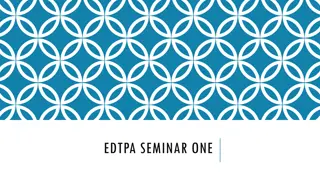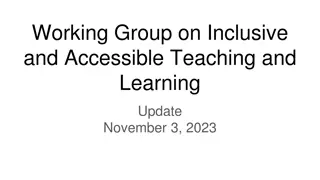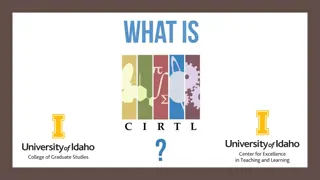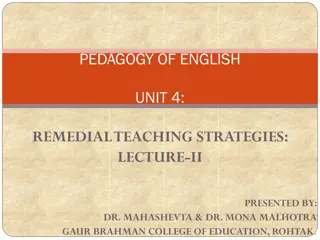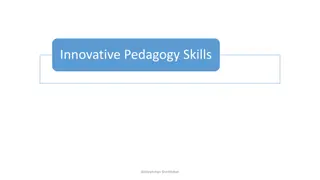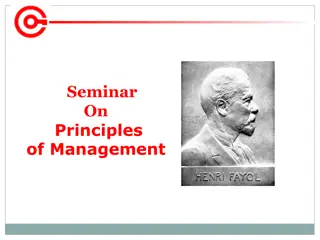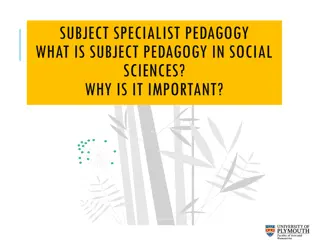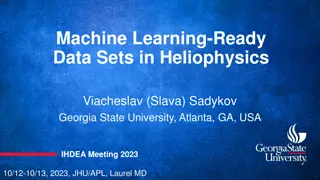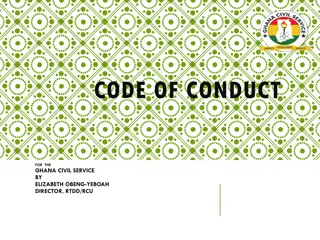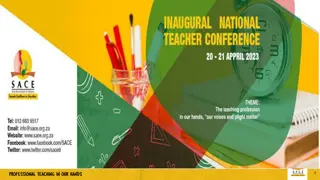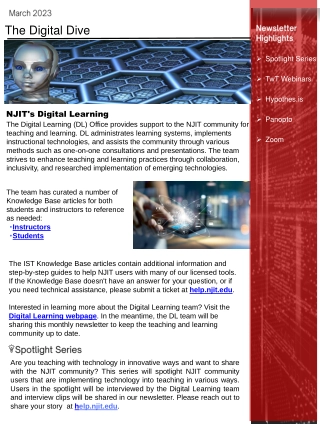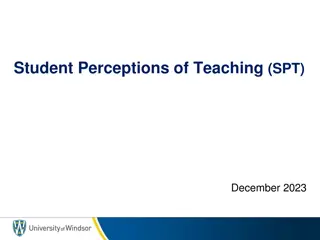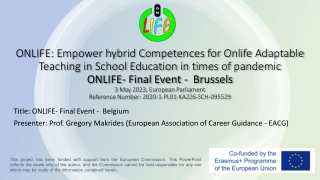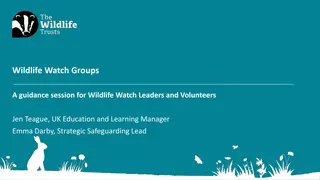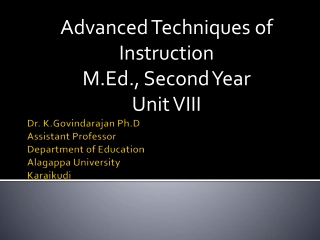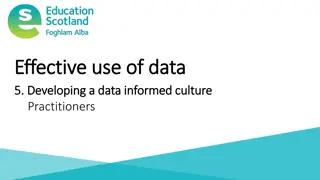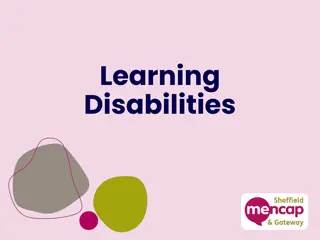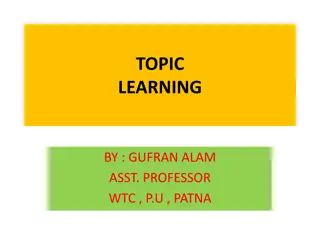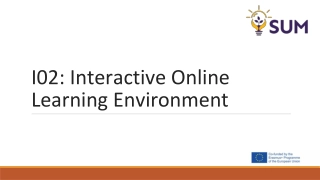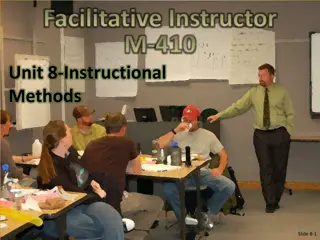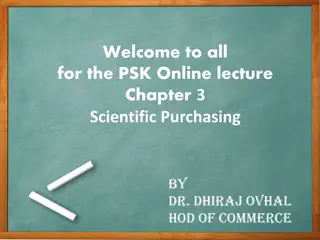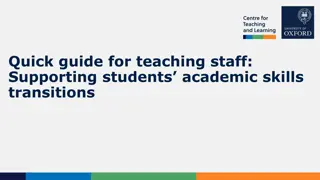Key Principles for Effective Learning and Teaching
Establish guiding principles for learning and teaching based on Quality Questioning, Developing High-Quality Skills, High Level of Challenge, and Feedback for Improvement. Emphasize differentiation, critical thinking, creativity, high expectations, and self-regulation to enhance student engagement and achievement.
Download Presentation
Please find below an Image/Link to download the presentation.
The content on the website is provided AS IS for your information and personal use only. It may not be sold, licensed, or shared on other websites without obtaining consent from the author. Download presentation by click this link. If you encounter any issues during the download, it is possible that the publisher has removed the file from their server.
Uploaded on Mar 20, 2024 | 1 Views
Presentation Transcript
Aim of this session To establish what we want as the guiding principles for learning and teaching.
Current position We currently have 5 themes of excellence to guide learning and teaching. Do we want to keep or modify any? Other alternative approach is shown. What would your AoLE/Dept prefer? Please email responses to SLT team
1. Quality Questioning (D) Including differentiation (provision) SOLO lesson intentions or Big Questions Questioning is planned and differentiated to check for depth of understanding Questions are used effectively to help scaffold improvement Different types of questions are modelled and highlighted Learners understand what a good question for learning is and regularly ask these questions. (Opportunities for pupils to ask questions).
2. Developing high quality skills e.g. literacy, numeracy, DCF and wider skills across the curriculum.(E)(I) Skills will be developed for mandatory and integral skills in the CfW 2022 Planning and organisation Implementing solution, executing ideas, and monitoring and reflecting on results Critical thinking and problem-solving Marshalling critical and logical processes to analyse and understand situations and develop responses and solutions Creativity and innovation Generation of ideas, openness and courage to explore ideas and express opinions. Personal effectiveness Reflecting on and understanding oneself and others, behaving in effective and appropriate ways; being an effective learner
3. High Level of Challenge Plan the needs for the highest ability students and work downwards; Have high expectations, clear routines, and learners are guided to reach their potential in a disciplined, structured environment Set clear, stretching and measureable intentions linked to student data Plan engaging learning activities with extension and challenge tasks always available (Engage, Produce, Evaluate).
4. Feedback for improvement (not just marking) Self-regulation, role-modelling from teacher and pupils High quality work is modelled and analysed Learners understand clearly the specific features that make work high quality Feedback for improvement from teachers and peers is kind, helpful and specific Learners given regular opportunities to improve their own work.
5. Visible progress in learning Regular and appropriate reviews against lesson intentions or Big question Clear success criteria shared or co-constructed for learning tasks and used as a checklist for progress Formative uses of assessment in order to support learning and teaching. A wide range of assessment techniques should be used to provide a picture of a learners progress and needs Learners should be active participants in the learning and assessment process, taking ownership of their own learning.
Example from another school
Example from another school 1. Expectation We care about our students as individual, and have the highest expectations of them and their behaviour Path to University We believe and take steps to ensure that every student at BHHS will have the option to go to university when they leave. Every Second counts We respect students time by ensuring every second is spent productively. We use timers and countdowns to measure time intentionally and strategically. Warm and demanding
Example from another school 2. Routines We warmly greet students (at the door), setting expectations before they enter the classroom. Silent Starter We maximise instructional time by beginning lessons with a short, silent activity that students can complete without instruction, based on the principles of spaced practice. Dismissal We support each other by dismissing students in silence and ready for the next lesson. Celebrate Success We use praise and positive reinforcement to encourage leadership, resilience and aspiration. * COVID change Threshold
Example from another school 3. Classroom Culture We allow students to think and write without interruption by ensuring tasks are completed in silence, unless directed otherwise. 100% We plan for the goal of 100% of the students meeting 100% of the expectations 100% of the time. Discipline We use the behaviour policy to ensure students receive consistent, fair consequences for poor behaviour. We reconnect positively after administering consequences.. Meeting the needs of all students We ensure all students succeed by making use of our progress packs to adapt teaching where necessary. Climate for Learning
Example from another school 4. Academic Challenge and Rigour We believe that it is not okay not to try. We use strategies to ensure an I don t know answer turns into success. Confident Communication We expect students to speak and write in full sentences. We give them opportunities to complete extended writing and we use wait time to allow students time to think before answering. Confident Readers We use control the game (accelerated reader for us) as a strategy to develop confident readers Challenge We deliver a broad, knowledge rich, academically challenging curriculum in a clear manner. We focus on building cultural capital (4 core purposes) and providing opportunities for independent practice. No OPT out
Example from another school 5. We expect students to take pride in their work and provide them with feedback according to the marking policy. Questioning We use cold calling to check for understanding and create a culture of engaged accountability. Circulating We move strategically around the room* during all parts of the lesson. Regular Review We aim to embed knowledge in the long term memory through regular quizzing and revisiting. * COVID change Checking for Understanding Books
Olchfa Greet Them Clear Presence Speedy Start Know Them Expect Participation Warm Demands Fixed Routines Praise Them Calm Close Expect the Best "Warm demander" teachers expect great things from their students, convince them of their own brilliance, and help them reach their potential in a disciplined, structured environment. All learning has a clear structure High levels of engagement are sustained Learners are sufficiently challenged Assessment for learning is embedded Cross-curricular requirements are meaningful and relevant





